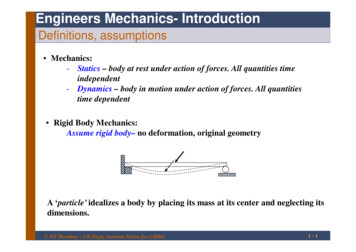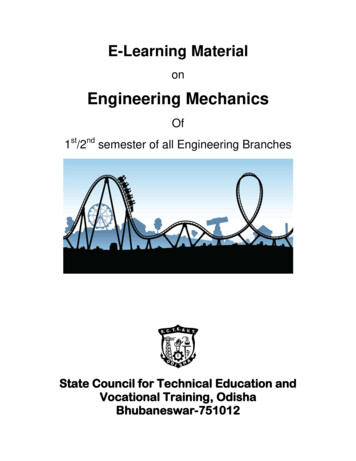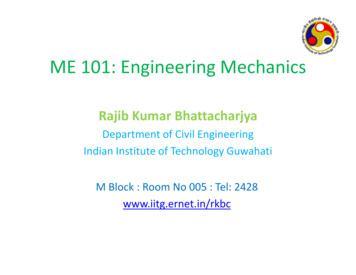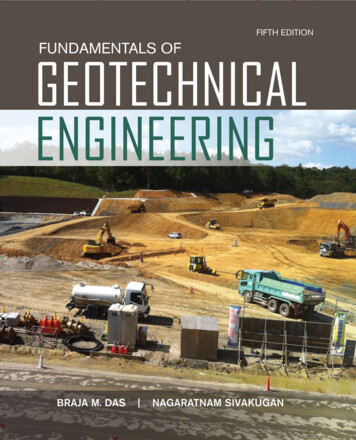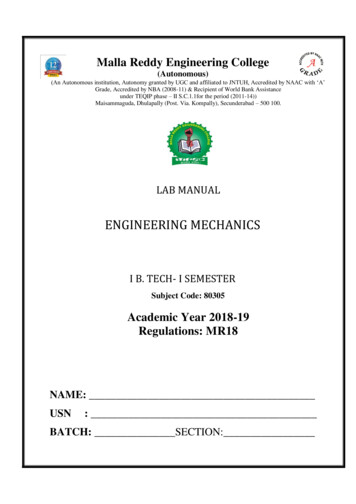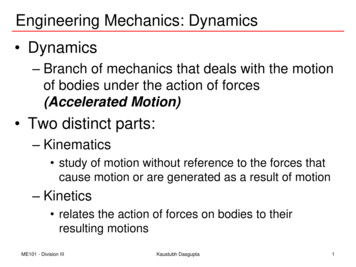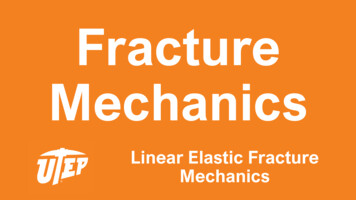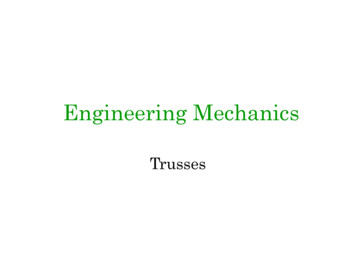
Transcription
Engineering MechanicsTrusses
Truss2
Definition of a Truss A truss is an assembly of straight membersconnected at joints. No member is continuousthrough a joint. Most structures are made of several trusses joinedtogether to form a space framework. Each trusscarries those loads which act in its plane and may betreated as a two-dimensional structure. Bolted or welded connections are assumed to bepinned together. Forces acting at the member endsreduce to a single force and no couple. Only twoforce members are considered. When forces tend to pull the member apart, it is intension. When the forces tend to compress themember, it is in compression.3
Definition of a TrussMembers of a truss are slender and not capable of supporting largelateral loads. Loads must be applied at the joints. Weights are assumed to be distributed to joints. External distributed loads transferred to joints via stringers and4floor beams.
Definition of a Truss5
Definition of a Truss6
Simple Trusses A rigid truss will not collapseunder the application of a load. A simple truss is constructed bysuccessively adding two membersand one connection to the basictriangular truss. In a simple truss, m 2j - 3where m is the total number ofmembers and j is the number ofjoints.7
Identify the Simple Trusses A simple truss is constructed bysuccessively adding two membersand one connection to the basictriangular truss. In a simple truss, m 2j - 3where m is the total number ofmembers and j is the number of8joints.
Identify the Simple Trussesm 45 j 24m 29 j 16 A simple truss is constructed by successively adding two membersand one connection to the basic triangular truss. In a simple truss, m 2j - 3 where m is the total number of membersand j is the number of joints.9
Analysis of Trusses by the Method of Joints Dismember the truss and create a free bodydiagram for each member and pin. The two forces exerted on each member areequal, have the same line of action, andopposite sense. Forces exerted by a member on the pins orjoints at its ends are directed along themember and equal and opposite. Conditions of equilibrium on the pinsprovide 2j equations for 2j unknowns. Fora simple truss, 2j m 3. May solve for mmember forces and 3 reaction forces at thesupports. Conditions for equilibrium for the entiretruss provide 3 additional equations whichare not independent of the pin equations. 10
Analysis of Trusses by the Method of Joints Use conditions forequilibrium for theentire truss to solvefor the reactions RAand RB.11
Analysis of Trusses by the Method of JointsAlternate Force Polygonfor Joint A12
Truss Connections andSupportsRiveted, Bolted, or WeldedExternal and internal (dotted) supports
Method of JointsNote the direction of the forces inthe members acting on the joints
Problem 27Determine the forces in the members in the following truss15
Problem 27 -SolutionConsider the FBD of the truss as shown to getythe unknown reactions at A and B as shown.Consider the equilibrium at each hinge to findthe force in the members.Assume tensile forces act on all the members.Ax1mAAyOverall equilibrium θB3m F 0 A 10 cos 45 0 A 7.07kN M 0 B 3 10 cos 45 1 10 sin 45 1.5 0 B F 0 A B 10 sin 45 A 1.18kNxxAyByxyyx10kN45o Cyyy 5.89kN16
As we are solving the problem using the method ofjoints, we take equilibrium at each point. As wehave assumed the forces in all the members aretensile, the direction of the reaction force they exertFBCon the hinges are as shown.123tan θ sin θ cos θ 1.51313Equilibrium at B xBBy 5.89 kNAx 7.07 kN Fy 0 FBC sin θ By 0 FBC 10.62kN FθFAB 0 FAB FBC cos θ 0 FAB 8.84kNFACAθFABAy 1.18 kNEquilibrium at A Fy 0 FAC sin θ Ay 0 FAC 2.13kN17
We assumed that all the forces in the members were tensile.But we got some of them negative. So, the negative signindicates that the forces in the members are compressive.2.13 kN10.62 kN8.84 kNFAB 8.84kN (T)FBC 10.62kN (C)FAC 2.13kN (C)18
Joints Under Special Loading Conditions Forces in opposite membersintersecting in two straight lines at ajoint are equal. The forces in two oppositemembers are equal when a load isaligned with a third member. Thethird member force is equal to theload P. When a joint connects only twomembers, the forces in twomembers are equal when they lie inthe same line. Zero force members Recognition of joints under specialloading conditions simplifies a trussanalysis.19
Problem 30 and 31 For the given loading, determine the zero forcemembers in the trusses shown20
Problem 30 - Solution Joint A is connected to two members and subjected toan external load P oriented along member AB.FAF 0 Joint L is connected to three members out of whichmembers LK and LM are in straight lines.FLG 021
Problem 30 - Solution Joint C is connected to three members out of whichmembers CB and CD are in straight lines.FCH 0 Joint N is connected to three members out of whichmembers MN and NO are in straight lines.FNI 022
Problem 30 - Solution Joint E is connected to two members which are not in astraight line.FEJ 0FED 023
Analysis of Trusses by the Method of Joints Dismember the truss and create a freebodydiagram for each member and pin. The two forces exerted on each member areequal, have the same line of action, and oppositesense. Forces exerted by a member on the pins or jointsat its ends are directed along the member andequal and opposite. Conditions of equilibrium on the pins provide 2nequations for 2n unknowns. For a simple truss,2n m 3. May solve for m member forces and3 reaction forces at the supports. Conditions for equilibrium for the entire trussprovide 3 additional equations which are notindependent of the pin equations.
Special Loading Conditions Can be recognized by using specializedco-ordinate axes
Analysis of Trusses by the Method of Sections When the force in only one memberor the forces in a very few membersare desired, the method of sectionsworks well. To determine the force in member BD,pass a section through the truss asshown and create a free body diagramfor the left side (or right side). With only three members cut by thesection, the equations for staticequilibrium may be applied todetermine the unknown memberforces, including FBD.26
Problem 1 Using method of joints, determine the forces inthe members of the trusses shown
Problem 2 For the given loading , determine thezero force member in the truss shown
Problem 5 Find the forces in members EF, KL, andGL for the Fink truss shown. You can usecombination of joints sections.EF 75.1 kN (C), KL 40 kN (T), GL 20 kN (T)
Problem 31.A Fink roof truss is loaded as shown in Fig 5. Usemethod of section to determine the force in members(a) BD, CD, and CE (b) FH, FG, EG
Problem 4 Use method of section to determine theforce in members IK, HK, FI, EG of thetruss shown in the figure.
Problem 6 The truss supports a ramp (shown with a dashed line) whichextends from a fixed approach level near joint F to a fixed exitlevel near J. The loads shown represent the weight of the ramp.Determine the forces in members BH and CD.
Important Notes For a truss to be properly constrained:– It should be able to stay in equilibrium for anycombination of loading.– Equilibrium implies both global equilibrium andinternal equilibrium. Note that if 2j m r, the truss is mostdefinitely partially constrained (and isunstable to certain loadings). But 2j m r, isno guarantee that the truss is stable. If 2j m r, the truss can never be staticallydeterminate.
Problem 7 Determine the forces in bars 1. 2. and 3 of theplane truss supported and loaded as shown inthe figure
Problem 8 Classify each of the structures as completely, partially, orimproperly constrained, further classify it as staticallydeterminate or indeterminate.BBB(a) 2j 20, m 16, r 3. Non-simple with 2j m 3, and thus the truss is partiallyconstrained. The truss is not internally rigid. A vertical load at point B cannot bebalanced.(b) 2j 20, m 15, r 3. Non-simple with 2j m 3. The truss is partially constrained.c) Non-simple. 2j 20, m 16, r 4.The circled part is a simple truss that is adequately supported with 3 reactions. So itis completely constrained, and can support any loading provided at the joints.We only have to worry about the remaining portion. We can easily show that nomatter whatever loading is applied at B can be supported. Completely constrained& Statically determinate
Problem 8 Classify each of the structures as completely, partially, orimproperly constrained, further classify it as staticallydeterminate or indeterminate.(a) Simple truss with four more than adequate supports. Internallyrigid, externally over-supported. j 9, m 13, r 4. 2j m r, soCompletely Constrained & Statically indeterminate.(b) j 10, m 16, r 4, 2j m r. Circled truss is simple trusswhich has enough reactions for global equilibrium. Thus it iscompletely constrained. The second truss is also simple and hasthree external reactions. Thus is also completely constrained.Completely constrained & Statically determinate.c) j 9, m 13, r 4, 2j m r. Incompletely constrained.
Problem 8 Classify each of the structures as completely, partially, orimproperly constrained, further classify it as staticallydeterminate or indeterminate.(a) j 8, m 12, r 4, 2j m r. Seemingly the truss is completelyconstrained. The circled portion is simple and adequatelyconstrained with 3 reactions. The remaining portion can take care ofany loading. Also not possible to deform the parallelogram.Completely constrained.(b) j 8, m 12, r 3, 2j m r. Partially Constrained
Problem 8BBa)j 8, m 12, r 4, 2j m r. But note that for the left truss, momentbalance about B is not obeyed. So the truss is Improperly constrainedb) j 7, m 10, r 3, 2j m r. Partially Constrainedc) j 8, r 3, m 13, 2j m r. Clearly the truss cannot be equilibriumwith this loading. Can be understood by equilibrium of joint B and C. Canalso be understood by taking a section as shown. ImproperlyConstrained.C
Problem 1 Determine the forces in members FH, EH, EG,LM, MK and LK.
Problem 2 Determine the forces in members BD and DE.
Problem 3 Determine the forces in members in AB, BC, AD, and AE.
Problem 4 Determine the forces in members AK, KE, andCE.
Engineering Mechanics Trusses . Truss 2. Definition of a Truss A truss is an assembly of straight members connected at joints. No member is continuous through a joint. Bolted or welded connections are assumed to be pinned together. Forces acting at the member ends reduce to a single force and no couple. .

